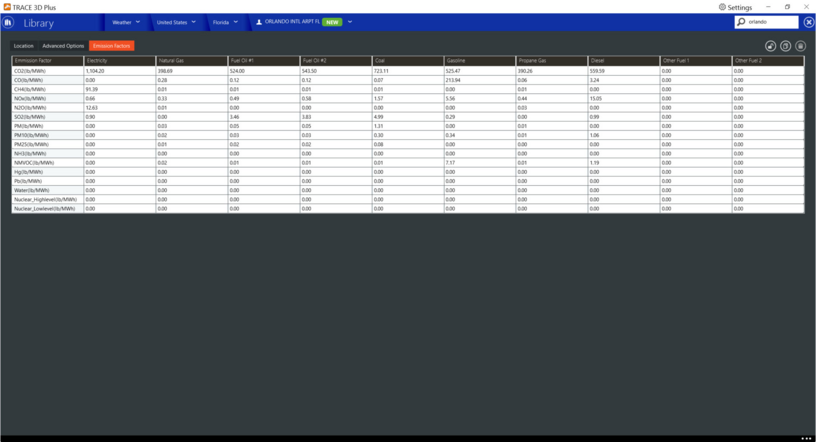Emission Factors
The Emission Factors tab allows you to enter the Emission Factors per fuel type in order to measure the Environmental Impact released to the atmosphere per contaminant while creating each type of utility.
Electricity Emission factors for every state in the United States are populated from the Emissions & Generation Resource Integrated Database (eGRID) 9th edition Version 1.0 State File (Year 2010 Data). All other non-US locations must be user populated to account for environmental impact reports.
This is found in the 3rd tab of the Standard Weather files.

If the emissions data is required to be updated for a Standard Trane Library member, a copy of the original library member must be made. The data can be edited in the table on the unlocked copy. Lock the copy before use in a Trace file.
There are ten allowable utility types: Electricity, Natural Gas, Fuel Oil #1, Fuel Oil #2, Coal, Gasoline, Propane, Diesel, Other Fuel #1 and Other Fuel #2.

The emission factors are:
-
NOx Emission Factor is the mass of nitrogen oxides released into the atmosphere for each utility type.
-
SO2 Emission Factor is the mass of sulfur dioxide released into the atmosphere for each utility type.
-
CO2 Emission Factor is the mass of carbon dioxide released into the atmosphere for each utility type.
-
CH4 Emission Factor is the mass of methane released into the atmosphere for each utility type.
-
N2O Emission Factor is the mass of nitrous oxide released into the atmosphere for each utility type.
-
CO Emission Factor is the mass of carbon monoxide released into the atmosphere for each utility type.
-
Hg Emission Factor is the mass of mercury released into the atmosphere for each utility type.
-
NH3 Emission Factor is the mass of ammonia released into the atmosphere for each utility type.NMVOC Emission Factor is the mass of non-methane volatile organic compounds (which include propane, butane, and ethane) released into the atmosphere for each utility type.
-
Pb Emission Factor is the mass of lead released into the atmosphere for each Fuel type.
-
M Emission Factor is the mass of particulate matter (including PM10 and PM2.5) released into the atmosphere for each utility type.
-
PM10 Emission Factor is the mass of particulate matter 10 (with an aerodynamic diameter of less than 10 microns) released into the atmosphere for each Fuel type.
-
PM2.5 Emission Factor is the mass of particulate matter 2.5 (2.5 microns in diameter or smaller) released into the atmosphere for each utility type.
-
Water Emission Factor is volume of water consumed or evaporated in the generation of each utility type.
-
Nuclear High Level Emission Factor is the mass of high-level nuclear waste, removed as spent nuclear fuel from a nuclear reactor once it no longer is efficient at powering the reactor. Once a year, approximately one-third of nuclear fuel is replaced with new fuel. This used fuel is called spent nuclear fuel and is highly radioactive; containing plutonium and other radionuclides.
-
Nuclear Low Level Emission Factor is the volume of low-level nuclear waste, removed from a nuclear reactor after radiation contamination.
|
Default: Default values for the other utility types are an example, real values per state should be entered
|
|
Min & Max: 0 to 100
|
|
Typical Range: N/A
|
|
Units: lb/MWh; g/MJ
|